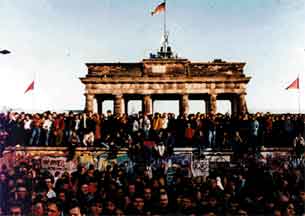1989 Fall of the Berlin Wall

Lech Wałęsa and President Bush
On October 18th, the regime of Erich Hoenecker, the Communist leader of East Germany, fell. It succumbed to increasing riots, as well as a flood of East Germans leaving via the open borders of Hungary. On November 10th, the new government announced the end of all travel restrictions, and soon thousands of Berliners took part in taking down the Berlin Wall that had divided the city for 27 years. ..
The Berlin Wall was constructed in 1961 by the government of East Germany as a means of preventing its citizens from fleeing to the West. The wall was made of concrete and barbed wire, and it was heavily guarded .
For nearly three decades, the Berlin Wall stood as a symbol of the division between East and West. It was a physical barrier that separated families, friends, and even businesses. The East German government controlled all movement across the wall, and anyone caught trying to cross it risked being shot by border guards. Despite the risks, many East Germans attempted to flee to the West, often risking their lives in the process.
In the 1980s, a series of events began to erode the power of the East German government and the communist system it represented. Economic stagnation, political repression, and social unrest were all factors that contributed to a growing sense of dissatisfaction among East Germans. The Soviet Union, which had long been the dominant power in the region, was also experiencing its own economic and political problems, which made it less able to support the East German government.
The fall of the Berlin Wall was preceded by a series of protests and demonstrations throughout East Germany. In the summer and fall of 1989, thousands of East Germans took to the streets to demand reform and greater freedom. These protests were met with brutal repression by the government, but they continued to grow in size and intensity.
On November 9, 1989, the East German government announced that it would allow its citizens to cross the border into West Germany. This announcement was made in response to mounting pressure from the protests and the deteriorating situation in the country. The news spread quickly, and thousands of East Germans flocked to the wall to cross over to the West. The border guards, who had been given no orders to open the wall, were quickly overwhelmed by the crowds.
The fall of the Berlin Wall was a moment of great joy and daycelebration for Germans, both East and West. It marked the end of an era of division and repression and the beginning of a new era of freedom and democracy.
 >
>